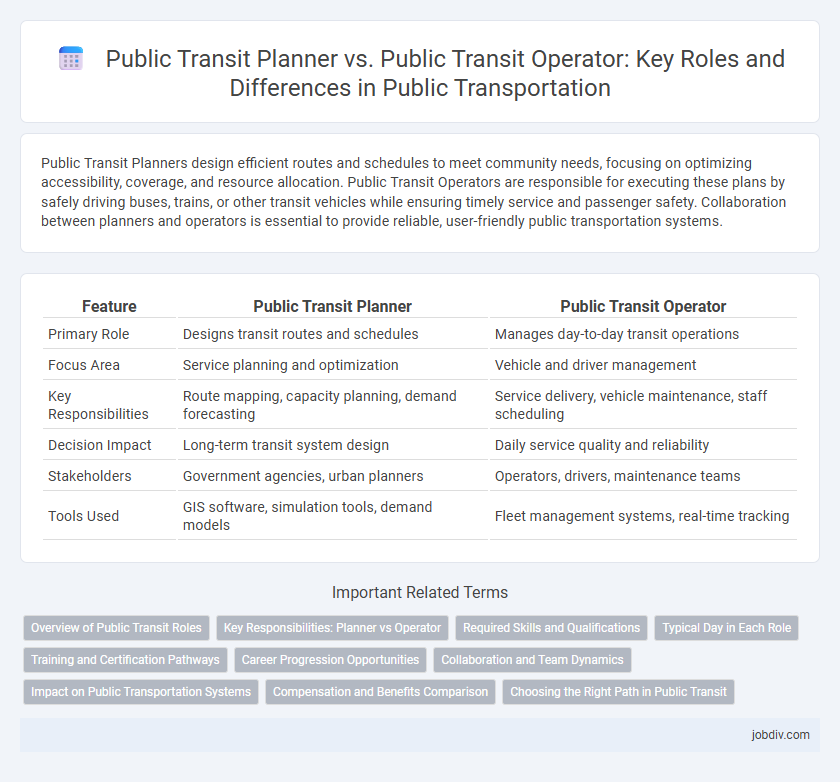Public Transit Planners design efficient routes and schedules to meet community needs, focusing on optimizing accessibility, coverage, and resource allocation. Public Transit Operators are responsible for executing these plans by safely driving buses, trains, or other transit vehicles while ensuring timely service and passenger safety. Collaboration between planners and operators is essential to provide reliable, user-friendly public transportation systems.
Table of Comparison
| Feature | Public Transit Planner | Public Transit Operator |
|---|---|---|
| Primary Role | Designs transit routes and schedules | Manages day-to-day transit operations |
| Focus Area | Service planning and optimization | Vehicle and driver management |
| Key Responsibilities | Route mapping, capacity planning, demand forecasting | Service delivery, vehicle maintenance, staff scheduling |
| Decision Impact | Long-term transit system design | Daily service quality and reliability |
| Stakeholders | Government agencies, urban planners | Operators, drivers, maintenance teams |
| Tools Used | GIS software, simulation tools, demand models | Fleet management systems, real-time tracking |
Overview of Public Transit Roles
Public Transit Planners analyze transportation data and community needs to design efficient transit routes, schedules, and policies that enhance accessibility and reduce congestion. Public Transit Operators are responsible for the day-to-day functioning of transit services, including driving vehicles, ensuring passenger safety, and maintaining schedules. Collaboration between planners and operators ensures seamless public transit systems that meet operational demands and passenger expectations.
Key Responsibilities: Planner vs Operator
Public Transit Planners develop efficient route designs, analyze ridership data, and coordinate schedules to optimize public transportation systems. Public Transit Operators are responsible for safely driving buses, trains, or trams, adhering to schedules, and providing customer service to ensure reliable daily operations. Planners focus on strategic system improvement and long-term planning while operators concentrate on executing transit services and maintaining operational safety.
Required Skills and Qualifications
Public Transit Planners require strong analytical skills, proficiency in data analysis software, and expertise in urban planning or transportation engineering to design efficient transit systems. Public Transit Operators must possess excellent driving skills, knowledge of safety regulations, and effective communication abilities to manage daily vehicle operations and ensure passenger safety. Both roles demand a comprehensive understanding of transit schedules, regulatory compliance, and customer service principles to support public transportation goals.
Typical Day in Each Role
A Public Transit Planner typically analyzes passenger data and designs efficient route maps to improve service coverage and reduce travel time, often collaborating with urban developers and transportation agencies. A Public Transit Operator focuses on the real-time execution of transit routes, managing vehicle operations, adhering to schedules, and ensuring passenger safety during daily runs. Both roles are critical in delivering reliable public transportation but prioritize strategic planning versus hands-on operational management.
Training and Certification Pathways
Public Transit Planners require specialized training in urban planning, transportation systems, and data analysis, often earning certifications such as AICP (American Institute of Certified Planners) or PTP (Professional Transportation Planner) to enhance their expertise. Public Transit Operators undergo rigorous operational training, including safety protocols, vehicle handling, and customer service, with mandatory certifications like CDL (Commercial Driver's License) and transit-specific endorsements to ensure compliance and proficiency. Both roles prioritize continuous professional development to stay updated with evolving industry standards and technologies.
Career Progression Opportunities
Public Transit Planners focus on designing efficient transportation systems, analyzing data, and developing long-term strategies, often progressing to senior planning, project management, or transportation consulting roles. Public Transit Operators manage day-to-day vehicle operations, gaining experience that can lead to supervisory positions, dispatcher roles, or training coordinator jobs within transit agencies. Career progression in both fields can intersect through specialized training, certifications, and a comprehensive understanding of transit systems, enabling transitions into administrative or policy-making positions.
Collaboration and Team Dynamics
Collaboration between public transit planners and operators enhances service efficiency by aligning route designs with operational capabilities and rider demand. Effective communication and shared data platforms foster real-time problem-solving and coordinated responses to service disruptions. Strong team dynamics promote continuous feedback loops, enabling adjustments that improve overall transit system performance and user satisfaction.
Impact on Public Transportation Systems
Public Transit Planners design efficient routes and schedules that optimize coverage and reduce travel times, directly enhancing the accessibility and reliability of public transportation systems. Public Transit Operators implement these plans by managing daily operations, ensuring safety, and maintaining service punctuality, which directly influences rider satisfaction and system efficiency. Collaboration between planners and operators is critical for adapting to ridership trends, reducing operational costs, and improving overall urban mobility.
Compensation and Benefits Comparison
Public Transit Planners typically earn a median salary ranging from $60,000 to $85,000 annually, reflecting their role in strategizing and optimizing transit systems. Public Transit Operators, including bus and train drivers, earn a median wage between $40,000 and $55,000, often supplemented by overtime pay and shift differentials. Benefits for Planners commonly include comprehensive health insurance, retirement plans, and professional development opportunities, while Operators receive robust union-negotiated benefits, such as paid leave, health coverage, and pension plans.
Choosing the Right Path in Public Transit
Public Transit Planner designs efficient routes and schedules using data analytics and passenger demand to optimize transit coverage and reduce travel time. Public Transit Operator executes these plans by managing day-to-day vehicle operations, ensuring safety, and maintaining timely service for commuters. Selecting the right path in public transit depends on the synergy between strategic planning and effective operational management to deliver reliable and accessible transportation.
Public Transit Planner vs Public Transit Operator Infographic

 jobdiv.com
jobdiv.com